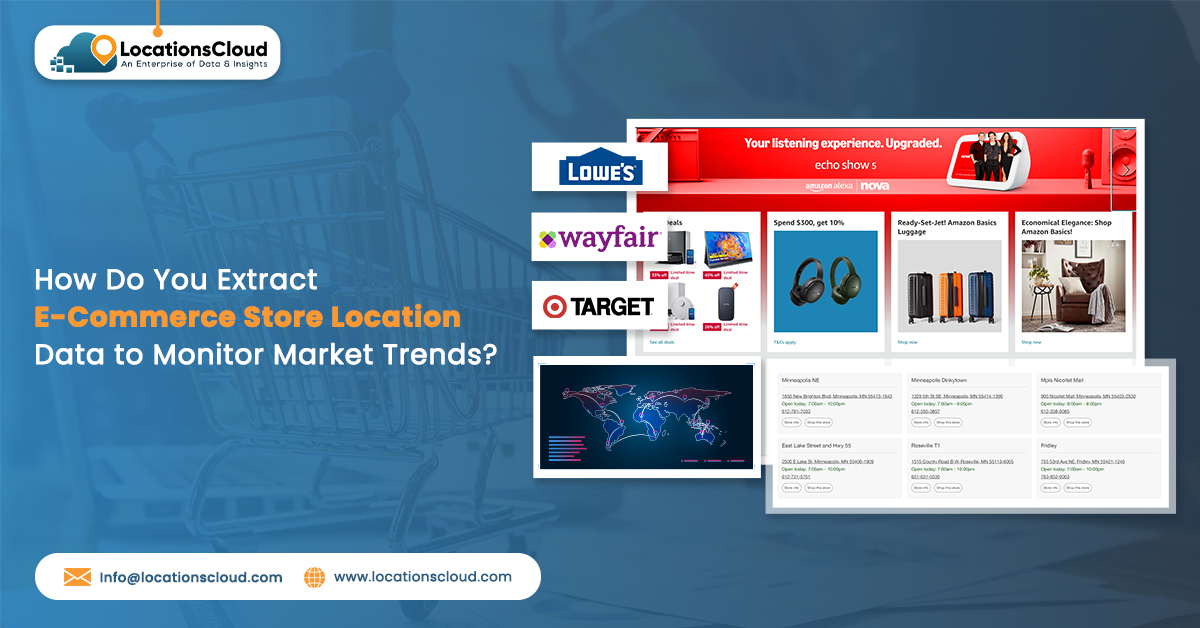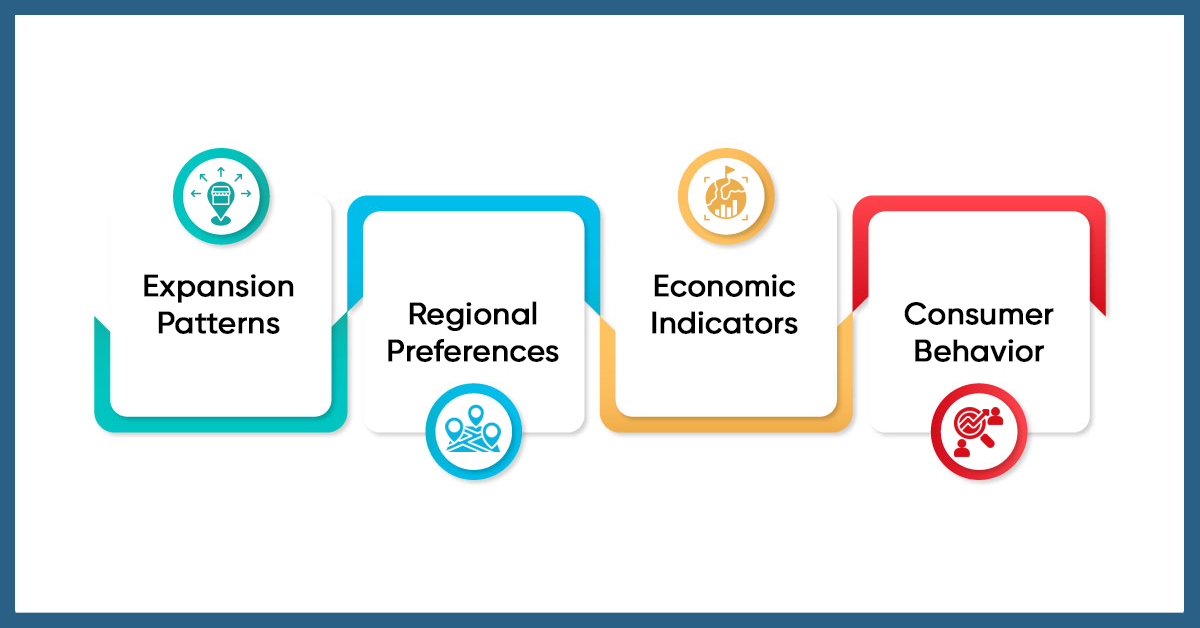
In the current world where so many businesses are present in the e-commerce sector it’s important to get proper information to plan and develop your business. Some of these insights can be collected through web scraping methods to get the store locator details. This entails collection of information from websites on store locations, operational time, services offered, and customer feedback. This is one of the ways through which businesses can enhance their market intelligence and analysis hence making desirable business decisions. Using the data available, patterns and trends that cannot be easily identified by observing the parameters from naked eyes can be easily pointed out which may be beneficial for companies.
Being in the business where most of the transactions are done online entails competing for the market with companies from all over the world. For 2023, the sales rates of ecommerce product are expected to increase by 8. 9%, it is to be equal to almost $ 6 trillion. To be competitive, get the customer’s trust, and make sure the brand is recognizable, you have to use modern tools to collect timely accurate information.
What is E-Commerce Store Location Data Scraping?
Today, the market is more data-oriented than ever, especially for online retail businesses where web scraping can turn a brand into an industry giant. E-commerce store location data scraping refers to companies employing special software to retrieve information regarding where an online store or a physical store is situated. This information typically consists of addresses, geographical coordinates such as latitudes and longitudes, and other relevant details regarding the location.
By obtaining this information from multiple web stores, organizations can discover where stores are located in several areas. This helps companies study the market trends, which in turn assists them in learning their competitors’ strategies and, therefore, forming their future market strategies. Thus, they can know where to open new stores, which markets should be targeted for product promotions, etc. Furthermore, it makes sense to follow where competitors are growing and establish a presence in the same places. Thus, businesses will be ready to anticipate competitors’ actions in terms of expansion.
How to Scrape E-Commerce Store Location Data To Track Market Trends?
eCommerce store location data helps in identifying patterns and trends, offering valuable insights for strategic decision-making. Scraping e-commerce store location data is a powerful tool that assist businesses in staying ahead of the competition and effectively responding to market dynamics.
Identifying Target Websites
Selecting E-Commerce Websites To start scraping e-commerce store location data, the first step is choosing which websites to target. You should consider websites that have comprehensive and reliable location data. Criteria for selecting these sites include:
- The popularity of the website.
- The relevance to your market.
- The completeness of their location information.
- The ease of extracting the data from their site structure.
Some of the sources are popular e-commerce sites such as Amazon, Walmart, eBay, Shopify, and others, which normally provide specific store locations with a comprehensive market area.
Analyzing Website Structure
To scrape data, it is necessary to know the structure of the selected sites. This requires a basic understanding of both HTML and CSS, as these are the languages used in developing web pages. Looking for the attributes containing the scrolling string and the CSS classes in the page source or by some other general object-oriented approach, one can understand how the data is grouped on the page. For example, the actual store locations might be defined in certain tags or have some class names that you can point out when you write the scraping script.
Tools and Technologies for Scraping
Several advanced tools can help scrape information from the web, and each tool has advantages. For eCommerce data scraping there are various tools and technologies are integrated. BeautifulSoup is a package in Python that provides simple ways to search, parse, and inquire HTML. Scrapy is a more paid framework that could be used for many more complicated scrapes and can handle large projects. Another tool amongst Selenium is used to access all possible types of web pages in a browser to interact and scrape dynamic web content requiring input commands to open. As such, its comparison entails considering factors such as the relative simplicity and adaptability of the tool or tool suite you are using to your scraping project’s requirements.
Setting Up Your Scraping Environment
After selecting these tools, you need to enter the development environment or set up your development environment. This will generally require setting up an application or software like Python and additional libraries like BeautifulSoup, Scrapy, or Selenium. You will also require an IDE, like PyCharm or Vs code, to write and test your code. Arranging this environment correctly guarantees that you have all the needed tools to enhance the development and testing of the web scraper.
How Location Data Can Provide Insights into Market Trends?

The extraction and subsequent analysis of stores’ location information may provide important market indicators.
Expansion Patterns
Expansion patterns are classified according to the way and the areas in which the competitors have established new outlets. This information is valuable as it reveals those sectors to which businesses are starting to gravitate and which might yield good returns to anyone willing to invest. If competitors are targeting a specific area, this implies a growing market or market potential in the area. This information could guide business organizations that wish to expand in the next conceivable future in areas that would yield the most satisfactory results.
Regional Preferences
Local preferences include assessing trends that indicate variation in sales of certain products and clientele in different areas. Identifying the latter means that businesses get to know their clientele in the various regions and the kind of products that suit each region. For instance, using a product that enjoys good sales in a particular region might not have a similar effect in another area. By respecting such differences, the companies in question can more effectively target their inventory and promotional campaigns for a given location, thus increasing the chances of sales and concomitant customer satisfaction.
Economic Indicators
Gross domestic product implies linking store locations with factors such as average household income and density population. Examining these economic factors assists in studying the areas that could be most productive for businesses. For instance, zones with higher levels of customers’ average income will have higher sales of luxurious products. Likewise, a high concentration of people might mean that the area contains more customers than others with fewer residents. It allows businesses to direct their activities where they are likely to succeed more than in other regions since the organization recognizes the value of the available resources.
Consumer Behavior
Consumer behavior analysis encompasses demography and its relation to footfall, number of stores, and so on in a particular area. It is used to decide where to site a store, what promotion to launch, and even what stock to order. They also look at the frequency and pattern of movement so that they can seek locations for new stores and plan when to popularize business Venues. Further, the knowledge of the consumers’ buying behavior leads towards procuring the correct goods of the proper quality for the customers without over-purchasing as well as under-purchasing solely to meet the consumers’ needs.
How E-Commerce Store Location Data Helps in Monitoring Market Trends?
In the modern world, with the abundance of Internet services, it is crucial to adapt to market trends. Location data is one of the tools that assists businesses in achieving this task effectively. Location data entails information about customers, their preferences, and trend direction in various areas.
Understanding Regional Preferences and Demand
The location data reveals what products people prefer in certain geographic locations. For instance, winter clothes are likely to sell more in a cold region, whereas trunks will do well in a coastal region. This helps manage the product flow from the manufacturing or supplier to the end consumer, thus avoiding cases of the product being stored for a long time or consumed slowly.
Optimizing Marketing Campaigns
Another way is that location data enables ad targeting based on the customers’ location. For instance, they can run promotions for cooler wear in the winter season and related merchandise in hotter seasons. This makes advertisements appropriate to the buyer so that there is a high likelihood that the buyer will buy a given product.
Enhancing Customer Segmentation
Geolocation data assists in enhancing enterprise customer profiles since it is an additional characteristic. It allows firms to learn what products are needed and wanted in various regions, which makes shopping more personalized.
Improving Supply Chain and Inventory Management
It will show which products will be popular in certain zones, and businesses can place their stocks closer to those zones. This helps to minimize the time and cost needed to transport goods from one point to the other. It also helps customers get their ordered products on time and avoid having stock out for their products.
Analyzing Competitor’s Performance
In addition, location data can also show where competitors are prospering. Businesses can gather information about a competitor to learn why they are successful in one region and fix the problems in their operation that make them less effective.
Facilitating Localized Content and Promotions
New customers can be attracted using location-specific offers and other content that is most applicable to the region. For instance, they can create promotions during festivals, month celebrations, or any other event to increase traffic or sales among their clients.
Predicting Seasonal and Cyclical Trends
Geolocation data allows companies to track fluctuations in sales tendency and realize that consumers tend to prefer some goods during, let’s say, summer more than during winter in certain areas. This makes it possible for companies to plan to satisfy customers’ needs all year round.
Enhancing User Experience with Localization
E-commerce platforms can apply this concept is by targeting different geographic locations and showing products of interest, preferred languages, and shipment options favored in those regions. This, in turn, makes shopping for goods less demanding and fun for customers.
Supporting Strategic Expansion Decisions
For businesses that seek to expand, location data will show them where they stand to benefit the most. Market size, customer behavior, and competition influence a firm’s growth strategies, and firms with this knowledge are well-positioned to grow in targeted areas.
Conclusion
Web scraping is among the technologies that have expanded the e-commerce industry. It assists in organizational decision processes by providing accurate web data insight, which leads to enhanced revenues and defined customer expectations. Scraping data about the locations of e-commerce stores is a powerful approach to identify when and where the businesses are opened and how the market changes with time. LocationsCloud provide extensive location data by selecting the proper website sources to scrape and using some programming languages such as Beautiful Soup, Scrapy, or Selenium, it is possible to gain more information on stores’ positions. It allows you to look through the bush of competitors’ activity and find probable promising regions and sectors for successful investments and development.


